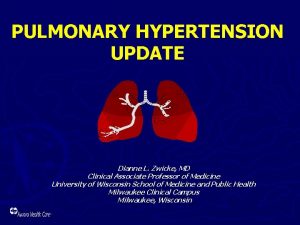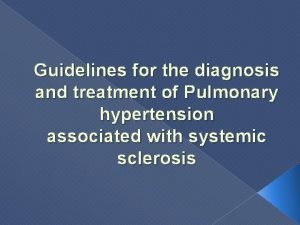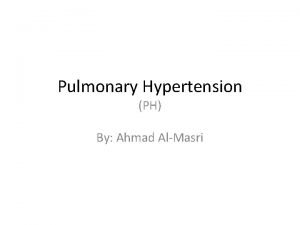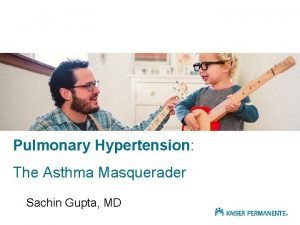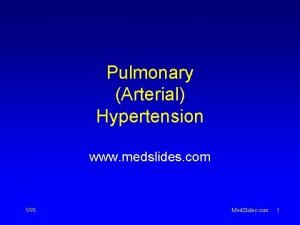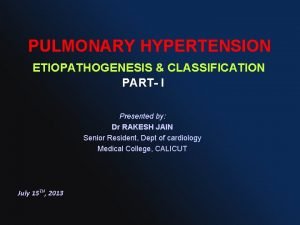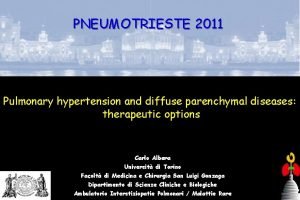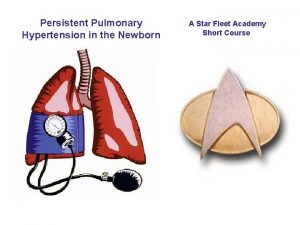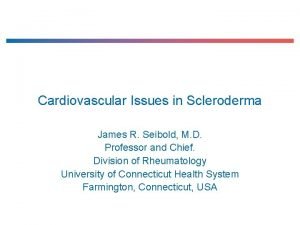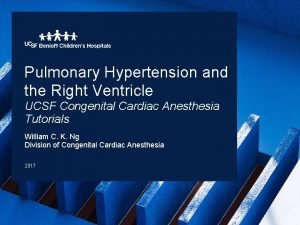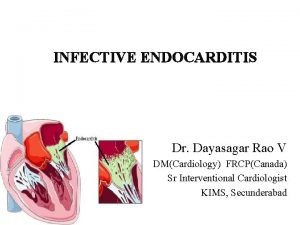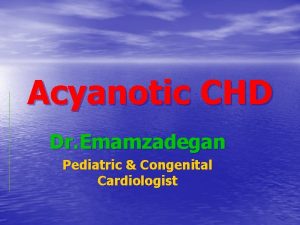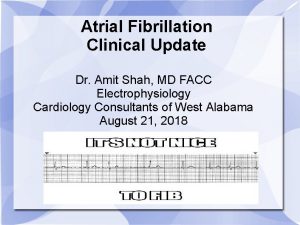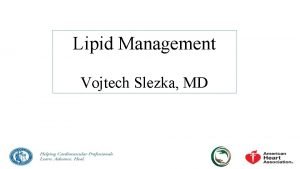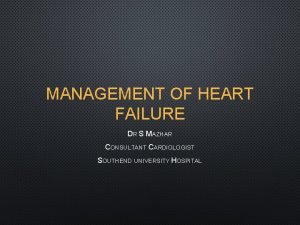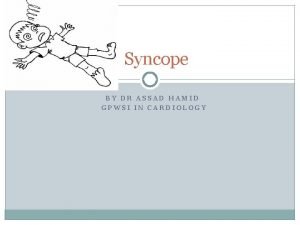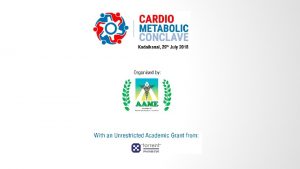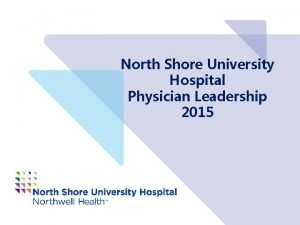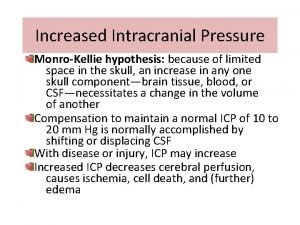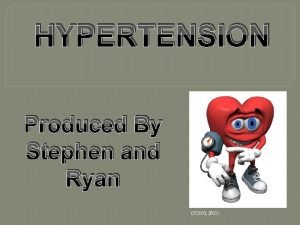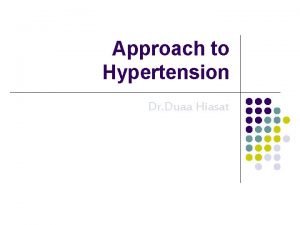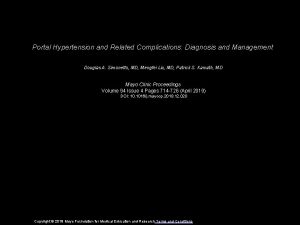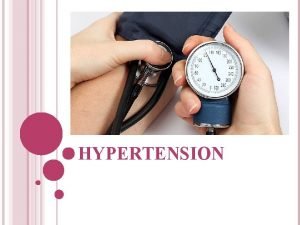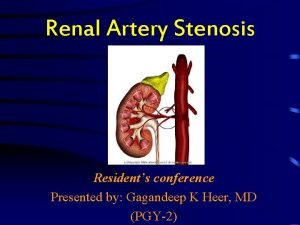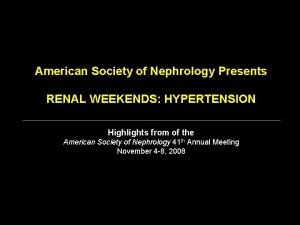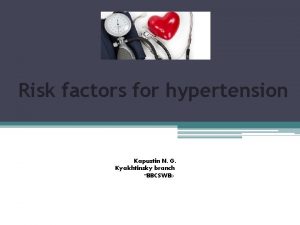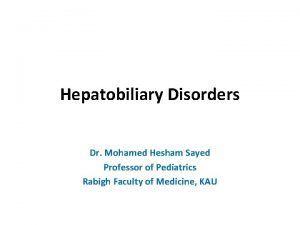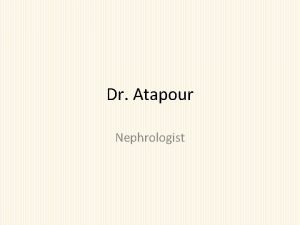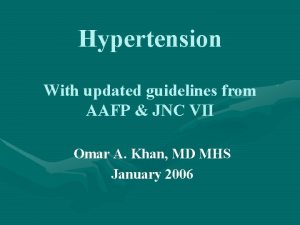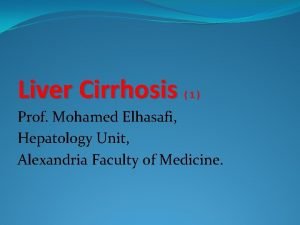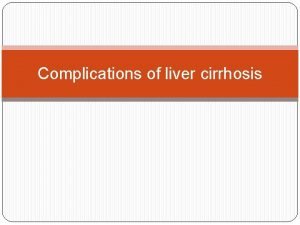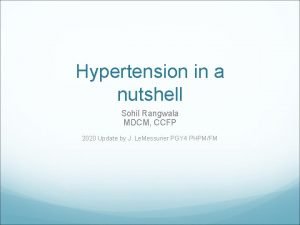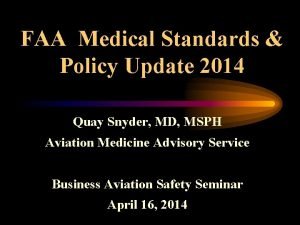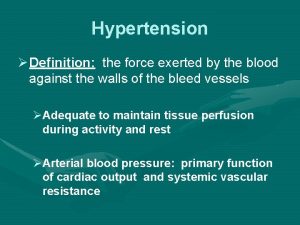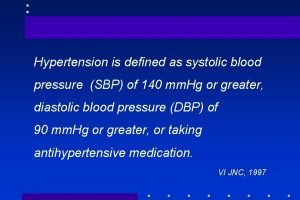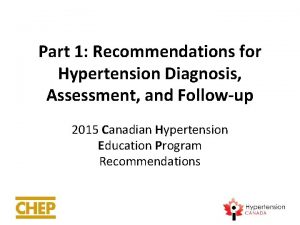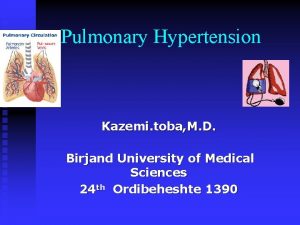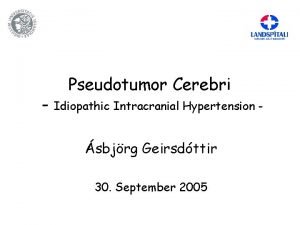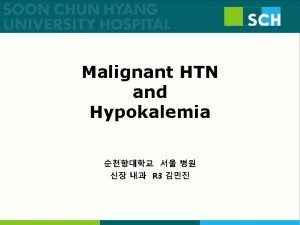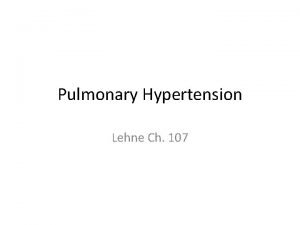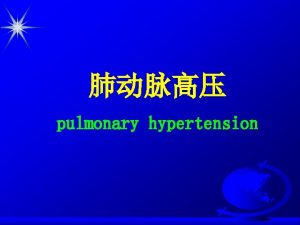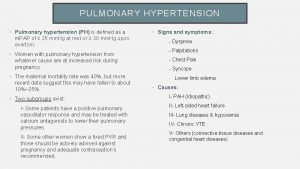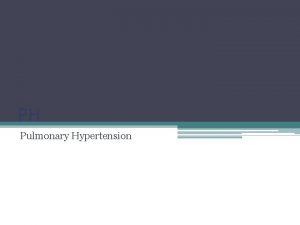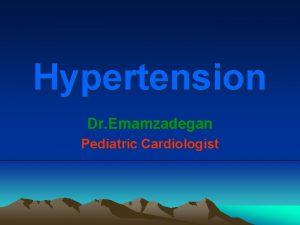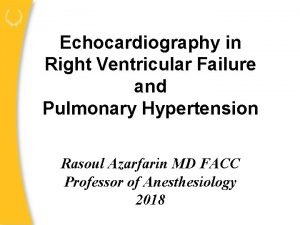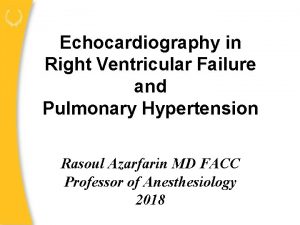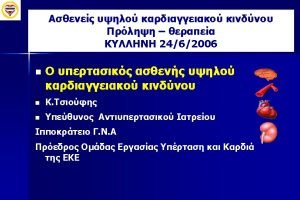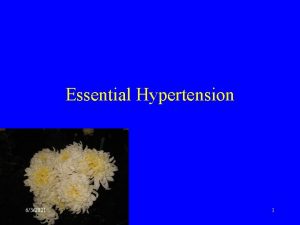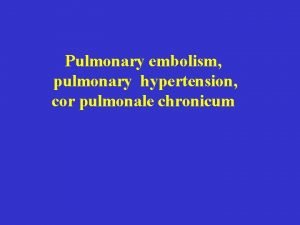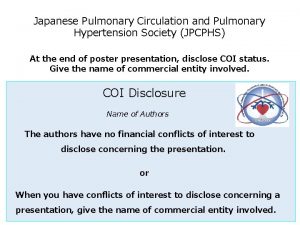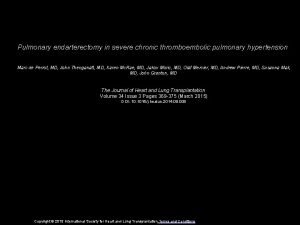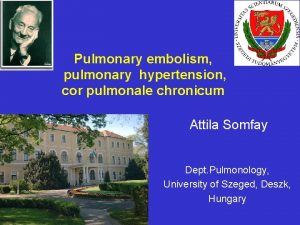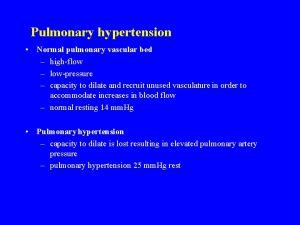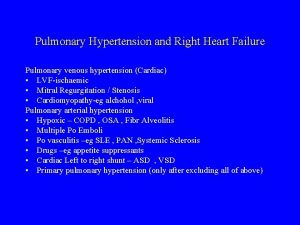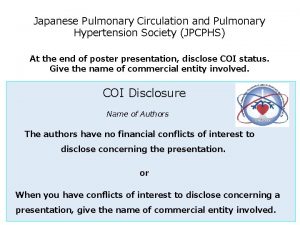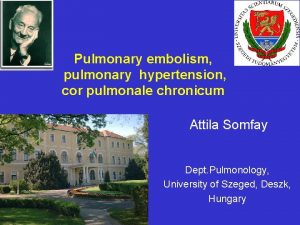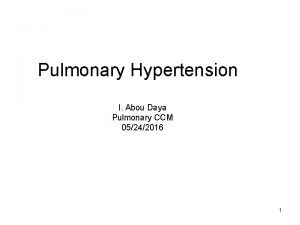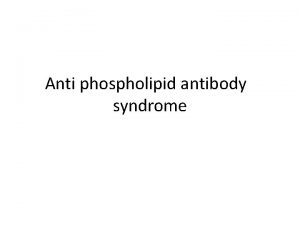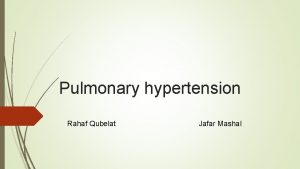Dr Mirdamadi Cardiologist Fellowship of Echocardiography PULMONARY HYPERTENSION























































- Slides: 55


Dr. Mirdamadi Cardiologist, Fellowship of Echocardiography PULMONARY HYPERTENSION

The lung has a unique double arterial blood supply from the pulmonary and bronchial arteries, as well as double venous drainage into the pulmonary and azygos veins � Pulmonary hypertension, an abnormal elevation in pulmonary artery pressure, may be the result of left heart failure, pulmonary parenchymal or vascular disease, thromboembolism, or a combination of these factors. �

Pathophysiology The right ventricle responds to an increase in pulmonary vascular resistance by increasing right ventricular (RV) systolic pressure to preserve cardiac output � In some patients, chronic changes occur in the pulmonary circulation, resulting in progressive remodeling of the vasculature, which can sustain or promote pulmonary hypertension even if the initiating factor is removed. �

The ability of the RV to adapt to increased vascular resistance is influenced by several factors, including age and the rapidity of the development of pulmonary hypertension � a large acute pulmonary thromboembolism can result in RV failure and shock, whereas chronic thromboembolic disease of equal severity may result in only mild exercise intolerance. �

Definitions � PH has been defined as an increase in mean pulmonary arterial pressure (PAP) 25 mm. Hg at rest as assessed by right heart catheterization


Diagnosis The most common symptom attributable to pulmonary hypertension is exertional dyspnea. Other common symptoms are fatigue, angina pectoris, syncope, near syncope, and peripheral edema � The physical examination typically reveals increased jugular venous pressure, a reduced carotid pulse, and a palpable RV impulse. Most patients have an increased pulmonic component of the second heart sound, a right-sided fourth heart sound, and tricuspid regurgitation �

The chest x-ray generally shows enlarged central pulmonary arteries. The lung fields may reveal other pathology. � The electrocardiogram usually shows right axis deviation and RV hypertrophy. � The echocardiogram commonly demonstrates RV and right atrial enlargement, a reduction in left ventricular (LV) cavity size, and a tricuspid regurgitant jet that can be used to estimate RV systolic pressure by Doppler. �

� Pulmonary function tests are helpful in documenting underlying obstructive airways disease, whereas highresolution chest computed tomography (CT) is preferred to diagnose restrictive lung disease. � A perfusion lung scan is almost always abnormal in patients with thromboembolic pulmonary hypertension

� Laboratory tests should include antinuclear antibody and HIV testing. � Because of the high frequency of thyroid abnormalities in patients with idiopathic pulmonary hypertension, it is recommended that the thyroidstimulating hormone level be determined periodically.

� Cardiac catheterization is mandatory for accurate measurement of pulmonary artery pressure, cardiac output, and LV filling pressure as well as documentation of an underlying cardiac shunt.



Pathobiology � Vasoconstriction, vascular proliferation, thrombosis, and inflammation appear to underlie the development of PAH � Abnormalities in multiple molecular pathways and genes that regulate the pulmonary vascular endothelial and smooth muscle cells have been identified.

Idiopathic Pulmonary Arterial Hypertension � Idiopathic pulmonary arterial hypertension (IPAH), formerly referred to as primary pulmonary hypertension, is uncommon, with an estimated incidence of two cases per million. There is a female predominance, with most patients presenting in the fourth and fifth decades, although the age range is from infancy to >60 years.

� Familial IPAH accounts for up to 20% of cases of IPAH and is characterized by autosomal dominant inheritance and incomplete penetrance.

Natural History � The natural history of IPAH is uncertain, but the disease typically is diagnosed late in its course. Before current therapies, a mean survival of 2– 3 years from the time of diagnosis was reported. � The cause of death is usually RV failure, which is manifest by progressive hypoxemia, tachycardia, hypotension, and edema.

Treatment � Because the pulmonary artery pressure in PAH increases with exercise, patients should be cautioned against participating in activities that impose physical stress. � Diuretic therapy relieves peripheral edema and may be useful in reducing RV volume overload.

� Anticoagulant therapy is advocated for all patients with PAH based on studies demonstrating that warfarin increases survival of patients with PAH. � Patients who respond to vasodilators at the time of cardiac catheterization should be treated with calcium channel blockers. these patients require high doses (e. g. , nifedipine, 240 mg/d, or amlodipine, 20 mg/d).

� The endothelin receptor antagonists bosentan and ambrisentan are approved treatments of PAH. � Sildenafil and tadalafil, phosphodiesterase-5 inhibitors, are approved for the treatment of PAH. � The prostacyclins have the greatest efficacy as treatments for PAH

� Lung transplantation is considered for patients who, while on an intravenous prostacyclin, continue to manifest right heart failure.


DEEP VENOUS THROMBOSIS AND PULMONARY THROMBOEMBOLISM

� Venous thromboembolism (VTE), which encompasses deep venous thrombosis (DVT) and pulmonary embolism (PE), is one of the three major cardiovascular causes of death, along with myocardial infarction and stroke

� In 1856, Rudolf Virchow postulated a triad of factors that predispose to intravascular coagulation: local trauma to the vessel wall, hypercoagulability, and stasis.

� the pathogenesis of PE has been dichotomized as caused by either inherited (primary) or acquired (secondary) risk factors. � combination of thrombophilia and acquired risk factors often precipitates overt thrombosis.

Risk Factors for Venous Thromboembolism � Obesity � Metabolic syndrome � Cigarette smoking � Hypertension � Abnormal lipid profile � High consumption of red meat and low consumption of fish, fruits, and vegetables

� � � Advancing age Arterial disease, including carotid and coronary disease Personal or family history of venous thromboembolism Recent surgery, trauma, or immobility, including stroke Congestive heart failure Chronic obstructive pulmonary disease Acute infection Air pollution Long-haul air travel Pregnancy, OCP, or postmenopausal HRT Pacemaker, ICD leads, or indwelling central venous catheter

� Hypercoagulable � Factor states V Leiden � Prothrombin gene mutation � Antithrombin deficiency � Protein C deficiency � Protein S deficiency � Antiphospholipid antibody syndrome

� increased risk of VTE with malignancyes: adenocarcinomas of the pancreas, stomach, lung, esophagus, prostate, and colon, � liquid tumors : myeloproliferative disease, lymphoma, and leukemia

The two most common genetic causes of thrombophilia are factor V Leiden and the prothrombin gene mutation � Normally, a specified amount of activated protein C (a. PC) can be added to plasma to prolong the a. PTT. � Patients with a. PC resistance have a blunted a. PTT prolongation and a predisposition to development of PE and DVT. �

� The phenotype of a. PC resistance is associated with a single point mutation, designated factor V Leiden, in the factor V gene

� Factor V Leiden triples the risk for development of VTE, also a risk factor for recurrent pregnancy loss, possibly caused by placental vein thrombosis. � Use of OCP by patients with factor V Leiden increases the risk of VTE by at least 10 -fold

� The most common acquired thrombophilia is the antiphospholipid syndrome

� When venous thrombi are dislodged from their site of formation, they embolize to the pulmonary arterial circulation or, paradoxically, to the arterial circulation through a patent foramen ovale or atrial septal defect.

� VTE mimics other illnesses, and PE is known as "the Great Masquerader, " making diagnosis difficult. � Occult PE is especially hard to detect when it occurs concomitantly with overt heart failure or pneumonia. In such circumstances, clinical improvement often fails to occur despite standard medical treatment of the concomitant illness

Pathophysiology - increased pulmonary vascular resistance caused by vascular obstruction, neurohumoral agents, or pulmonary artery baroreceptors; - impaired gas exchange caused by increased alveolar dead space from vascular obstruction and hypoxemia from alveolar hypoventilation, low ventilation-perfusion units, and right-to-left shunting - impaired carbon monoxide transfer caused by loss of gas exchange surface; - alveolar hyperventilation caused by reflex stimulation of irritant receptors -increased airway resistance due to bronchoconstriction; -decreased pulmonary compliance due to lung edema, lung hemorrhage, and loss of surfactant.

� Dyspnea is the most frequent symptom and tachypnea is the most frequent sign of PE

� Symptoms: � Otherwise unexplained dyspnea � Chest pain, either pleuritic or atypical � Anxiety � Cough

Signs: � Tachypnea � Tachycardia � Low-grade fever � Left parasternal lift � Tricuspid regurgitant murmur � Accentuated P 2 � Hemoptysis � Leg edema, erythema, tenderness �

� Differential Diagnosis of DVT: � Ruptured Baker's cyst � Cellulitis � Postphlebitic syndrome/venous insufficiency

Differential Diagnosis of PE: Pneumonia, asthma, chronic obstructive pulmonary disease � Congestive heart failure � Pericarditis � Pleurisy: "viral syndrome, " costochondritis, musculoskeletal discomfort � Rib fracture, pneumothorax � Acute coronary syndrome � Anxiety � �

Clinical Decision Rules

Clinical Decision Rules

NON IMAGING DIAGNOSTIC MODALITIES

� � � d-dimer rises in the presence of DVT or PE because of the breakdown of fibrin by plasmin. The sensitivity of the d-dimer is >80% for DVT and >95% for PE. The d-dimer assay is not specific. Levels increase in patients with myocardial infarction, pneumonia, sepsis, cancer, and the postoperative state and those in the second or third trimester of pregnancy. d-dimer rarely has a useful role among hospitalized patients, because levels are frequently elevated due to systemic illness. The d-dimer is a useful "rule out" test.

Electrocardiogram � The most frequently cited abnormality: � sinus tachycardia � S 1 Q 3 T 3 sign: an S wave in lead I, a Q wave in lead III, and an inverted T wave in lead III � T-wave inversion in leads V 1 to V 4.

Noninvasive Imaging Modalities � Venous Ultrasonography � Chest Roentgenography � Chest CT � Lung Scanning(Ventilation, perfusion scan) � Magnetic Resonance (Contrast. Enhanced) � Echocardiography

Invasive Diagnostic Modalities � Pulmonary Angiography � Contrast Phlebography





Thank you for your attention
 Dianne zwicke
Dianne zwicke Pulmonary hypertension
Pulmonary hypertension Pulmonary hypertension definition
Pulmonary hypertension definition Chd pulmonary hypertension
Chd pulmonary hypertension Med
Med Nervous mechanism for regulation of blood pressure
Nervous mechanism for regulation of blood pressure Bmpr gene
Bmpr gene Pulmonary hypertension
Pulmonary hypertension Paedp echo
Paedp echo Mitral stenosis pulmonary hypertension
Mitral stenosis pulmonary hypertension Stages of pulmonary hypertension
Stages of pulmonary hypertension Nt pro brain natriuretic peptide
Nt pro brain natriuretic peptide Echocardiography
Echocardiography Diastolic dysfunction echocardiography
Diastolic dysfunction echocardiography Modified duke criteria 2020
Modified duke criteria 2020 Congenital cardiologist near me
Congenital cardiologist near me Dr amit shah cardiologist
Dr amit shah cardiologist Dr siegfried cardiologist
Dr siegfried cardiologist Slezka
Slezka Dr mazhar cardiologist
Dr mazhar cardiologist Dr nick gall cardiologist
Dr nick gall cardiologist Cardiologist in kodaikanal
Cardiologist in kodaikanal Dr lee richstone
Dr lee richstone Dr sriram rajagopal cardiologist
Dr sriram rajagopal cardiologist Dr susan nolan
Dr susan nolan Intracranial hypertension
Intracranial hypertension Conclusion of hypertension
Conclusion of hypertension Cataractectomy
Cataractectomy Dr douglas simonetto
Dr douglas simonetto Signs of portal hypertension
Signs of portal hypertension Hypertension drugs
Hypertension drugs Rules of halves in hypertension
Rules of halves in hypertension Dyslipidemia pathophysiology
Dyslipidemia pathophysiology Hypertension
Hypertension Hypertension
Hypertension May kuster perforator
May kuster perforator Conclusion of hypertension
Conclusion of hypertension Conclusion of hypertension
Conclusion of hypertension Neonatal liver failure
Neonatal liver failure Causes of secondary hypertension
Causes of secondary hypertension Hypertension
Hypertension Jnc 7 hypertension
Jnc 7 hypertension Presinusoidal portal hypertension
Presinusoidal portal hypertension Complication of liver cirrhosis
Complication of liver cirrhosis Sohil rangwala
Sohil rangwala Essential hypertension
Essential hypertension Faa hypertension worksheet
Faa hypertension worksheet Hypertension medical definition
Hypertension medical definition Hypertensive emergency vs urgency
Hypertensive emergency vs urgency Diagnosis hypertension
Diagnosis hypertension Hypertension
Hypertension Jnc7
Jnc7 Intracranial hypertension
Intracranial hypertension Medical nutrition therapy for hypertension
Medical nutrition therapy for hypertension Malignant hypertension treatment
Malignant hypertension treatment Ocular hypertension dvla
Ocular hypertension dvla
